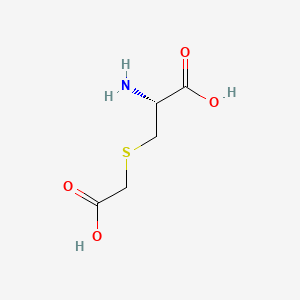



1. 3-(carboxymethylthio)alanine
2. Carbocysteine, L Isomer
3. Carbocysteine, L-isomer
4. L-isomer Carbocysteine
5. Mucodine
6. Mucodyne
7. Mukodin
8. Rhinathiol
9. S Carboxymethylcysteine
10. S-(carboxymethyl)-l-cysteine
11. S-carboxymethylcysteine
12. Thiodril
1. 638-23-3
2. S-carboxymethyl-l-cysteine
3. Carbocisteine
4. Carbocistein
5. S-(carboxymethyl)-l-cysteine
6. Mucodyne
7. Reomucil
8. Rhinathiol
9. Transbronchin
10. Lisomucil
11. Muciclar
12. Mucolase
13. Mucocis
14. Siroxyl
15. Loviscol
16. Mucofan
17. Bronchokod
18. Carbocit
19. Mucopront
20. Mucotab
21. Pectox
22. Lisil
23. Pectdrill
24. L-carbocisteine
25. H-cys(carboxymethyl)-oh
26. (r)-s-(carboxymethyl)cysteine
27. 186537-58-6
28. Carbocisteina
29. Carbocisteinum
30. Mucolex
31. Pulmoclase
32. Rinatiol
33. L-carbocysteine
34. S-(carboxymethyl)-(r)-cysteine
35. L-3-((carboxymethyl)thio)alanine
36. Superthiol Sirup
37. Thiodril
38. Lj 206
39. Methista
40. (l)-2-amino-3-(carboxymethylthio)propionic Acid
41. S-carboxymethylcysteine
42. Carbocisteine [inn]
43. 3-(carboxymethylthio)-l-alanine
44. R05cb03
45. Ahr 3053
46. Ahr-3053
47. Df 1794y
48. Nsc 14156
49. (2r)-2-amino-3-(carboxymethylsulfanyl)propanoic Acid
50. (2r)-2-amino-3-[(carboxymethyl)sulfanyl]propanoic Acid
51. L-cysteine, S-(carboxymethyl)-
52. Chembl396416
53. Chebi:16163
54. 740j2qx53r
55. Lj-206
56. Nsc-14156
57. Carbocysteine [usan]
58. Alanine, 3-((carboxymethyl)thio)-, L-
59. Chilvax
60. Mucosol
61. Carboxymethylated Cysteine
62. S-carboxylmethyl-l-cysteine
63. Broncodeterge
64. 1391068-19-1
65. Mucotron
66. Mukinyl
67. 3-((carboxymethyl)thio)-l-alanine
68. Mucojet Sirup
69. Mucolex Sirup
70. L-(carboxymethyl)cysteine
71. Scmc
72. (r)-2-amino-3-(carboxymethylthio)propanoic Acid
73. 3-((carboxymethyl)thio)alanine
74. 3-[(carboxymethyl)thio]alanine
75. Carbocisteinum [inn-latin]
76. Carbocisteina [inn-spanish]
77. Unii-740j2qx53r
78. Carbocysteine [usan:inn:ban]
79. L.j.206
80. (2r)-2-azaniumyl-3-(carboxylatomethylsulfanyl)propanoate
81. Mucodyne (tn)
82. Einecs 211-327-5
83. Carbocistein [jan]
84. Mfcd00002614
85. Carbocysteine Dl-form
86. Brn 1725012
87. L.j. 206
88. Carbocysteine [mi]
89. L-carbocisteine (jp17)
90. Carbocisteine [jan]
91. Carbocysteine [inci]
92. Schembl20854
93. (2r)-2-amino-3-(carboxymethylthio)propanoic Acid
94. Carbocisteine [mart.]
95. L-carbocisteine [jan]
96. Hy-d0205a
97. (carboxymethyl)cysteine-, (l)-
98. Dtxsid30110060
99. L-carbocisteine [who-dd]
100. 3-(carboxymethylthio)alanine, L-
101. S-carboxymethyl-l-cysteine, 98%
102. Zinc1529732
103. Carbocisteine [ep Monograph]
104. Bdbm50213735
105. S5216
106. Akos015922826
107. 5-amino-3-thiadihexanoic Acid, (l)-
108. Db04339
109. Ac-11146
110. As-57938
111. Cs-0017457
112. C-1850
113. C03727
114. D00175
115. H11928
116. (2r)-2-amino-3-(carboxymethylthio)propionic Acid
117. A813055
118. A816956
119. A834542
120. Q423408
121. 2-amino-3-(carboxymethylthio)propionic Acid, (l)-
122. Q-200796
123. (2r)-3-(carboxythio)-2-(methylamino)propanoic Acid
124. (2r)-2-amino-3-((carboxymethyl)thio)propionic Acid
125. (2r)-2-azanyl-3-(2-hydroxy-2-oxoethylsulfanyl)propanoic Acid
126. Carbocisteine, European Pharmacopoeia (ep) Reference Standard
127. (2r)-2-amino-3-[(carboxymethyl)sulfanyl]propanoic Acids-(carboxymethyl)-l-cysteine
| Molecular Weight | 179.20 g/mol |
|---|---|
| Molecular Formula | C5H9NO4S |
| XLogP3 | -3.1 |
| Hydrogen Bond Donor Count | 3 |
| Hydrogen Bond Acceptor Count | 6 |
| Rotatable Bond Count | 5 |
| Exact Mass | 179.02522894 g/mol |
| Monoisotopic Mass | 179.02522894 g/mol |
| Topological Polar Surface Area | 126 Ų |
| Heavy Atom Count | 11 |
| Formal Charge | 0 |
| Complexity | 161 |
| Isotope Atom Count | 0 |
| Defined Atom Stereocenter Count | 1 |
| Undefined Atom Stereocenter Count | 0 |
| Defined Bond Stereocenter Count | 0 |
| Undefined Bond Stereocenter Count | 0 |
| Covalently Bonded Unit Count | 1 |
Carbocisteine is indicated over the counter and in prescription formulas to clear airway secretions in conditions associated with increased mucus.
Due to its mucolytic effects, carbocisteine significantly reduces sputum viscosity, cough, dyspnea and fatigue. Additionally, it prevents pulmonary infections by decreasing accumulated mucus in the respiratory tract; this is especially beneficial in preventing exacerbations of COPD caused by bacteria and viruses. It has in-vitro anti-inflammatory activity with some demonstrated action against free radicals.
Anti-Infective Agents, Local
Substances used on humans and other animals that destroy harmful microorganisms or inhibit their activity. They are distinguished from DISINFECTANTS, which are used on inanimate objects. (See all compounds classified as Anti-Infective Agents, Local.)
Expectorants
Agents that increase mucous excretion. Mucolytic agents, that is drugs that liquefy mucous secretions, are also included here. (See all compounds classified as Expectorants.)
R05CB03
S76 | LUXPHARMA | Pharmaceuticals Marketed in Luxembourg | Pharmaceuticals marketed in Luxembourg, as published by d'Gesondheetskeess (CNS, la caisse nationale de sante, www.cns.lu), mapped by name to structures using CompTox by R. Singh et al. (in prep.). List downloaded from https://cns.public.lu/en/legislations/textes-coordonnes/liste-med-comm.html. Dataset DOI:10.5281/zenodo.4587355
R - Respiratory system
R05 - Cough and cold preparations
R05C - Expectorants, excl. combinations with cough suppressants
R05CB - Mucolytics
R05CB03 - Carbocisteine
Absorption
Carbocisteine is rapidly absorbed in the gastrointestinal tract when taken orally with peak serum concentrations achieved within 1 to 1.7 hours.
Route of Elimination
About 30% to 60% of an orally administered dose is detected unchanged in the urine.
Volume of Distribution
Carbocisteine penetrates well into the lung and bronchial secretions.
Clearance
Clearance information for carbocisteine is not readily available in the literature.
Metabolic pathways for carbocisteine include acetylation, decarboxylation, and sulfoxidation, leading to the formation of pharmacologically inactive carbocisteine derivatives. Significant variability exists in metabolism due to genetic polymorphism in sulfoxidation capacity. Two cytosolic enzymes are responsible for the metabolism of carbocisteine: cysteine dioxygenase and phenylalanine 4-hydroxylase. Reduced metabolism can cause increased exposure to carbocisteine, explaining variable clinical response between patients who may polymorphisms affecting the enzymes responsible for carbocisteine metabolism. It is generally accepted that sulfodixation is the main metabolic pathway of carbocisteine, however, one group of researchers found a novel urinary metabolite, S-(carboxymethylthio)-L-cysteine (CMTC). No cysteinyl sulfoxide metabolites were found in the urine of patients taking carbocisteine in this study.
The plasma half-life of carbicostine is 1.33 hours.
The hypersecretion of mucus characterizes serious respiratory conditions including asthma, cystic fibrosis (CF), and chronic obstructive pulmonary disease (COPD). It blocks bacterial adherence to cells, preventing pulmonary infections. Glycoproteins (fucomucins, sialomucins and sulfomucins) regulate the viscoelastic properties of bronchial mucus. Increased fucomucins can be found in the mucus of patients with COPD. Carbocisteine serves to restore equilibrium between sialomucins and fucomucins, likely by intracellular stimulation of sialyl transferase enzyme, thus reducing mucus viscosity. A study found that L-carbocisteine can inhibit damage to cells by hydrogen peroxide (H2O2) by activating protein kinase B (Akt) phosphorylation, suggesting that carbocisteine may have antioxidant effects and prevent apoptosis of lung cells. There is some evidence that carbocisteine suppresses NF-B and ERK1/2 MAPK signalling pathways, reducing TNF-alpha induced inflammation in the lungs, as well as other inflammatory pathways. An in-vitro study found that L-carbocisteine reduces intracellular adhesion molecule 1 (ICAM-1), inhibiting rhinovirus 14 infection, thereby reducing airway inflammation.
